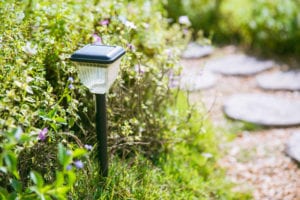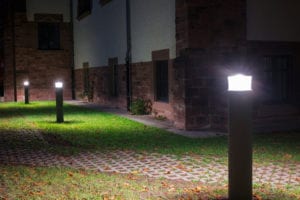Everyone wants a house that is both welcoming and beautiful. But welcoming guests starts well before they step in the front door. To make your home both safe and welcoming for family and friends, you will need to ensure a safe trip to the front door. At night, that means providing adequate lighting along the path to your front porch or entryway. If you’re hosting people in your garden or backyard, they will need the proper lighting to void obstacles as they move around your outdoor space. The most common type of lighting for getting around safely is path lighting. In this beginner’s guide to path lighting, we’ll discuss the different types of path lighting and how to use them to make your outdoor spaces both welcoming and beautiful.
The Cost Of Path Lighting
Path lighting is the most common type of lighting people install around their homes. It is also the first type of lighting most people install. But its simplicity can be deceptive. While path lighting can be relatively easy to install, it is also easy to install wrong. Many homeowners just don’t know much about path lighting and lighting design. Often this can lead to common path lighting mistakes that will make your design less beautiful, less efficient, and even less safe.
The main part of your path lighting system is the light fixture. This is also the most visible part. A light fixture is the entire structure of an individual path light. It includes the lamp (the technical term for a bulb) and the structure that houses the lamp. Path lighting fixtures could cost $3 a piece or $400 or more for designer fixtures. The choice is yours as to how much you want to spend. But it is worth noting that the very cheap fixtures are cheap for a reason. Poor quality is cheap. If you’re going to avoid really poor quality, expect to pay at least $25 a piece for good quality fixtures.
Wiring Path Lights
Besides the fixtures, the most important part of your path lighting system is the wiring. While it may be tempting to install your path lights in one long string from your transformer, you run the risk of voltage drop. The fixtures closest to the transformer could receive too much voltage, leading to shorter lamp life. The fixtures farthest from the transformer could also receive too little voltage, making them last longer but shine more dimly, defeating the purpose of path lighting altogether. The best method for wiring path lights is to use a T-shaped layout, with the transformer at the base of the T and the lights fanning out in two directions along the top of the T. Another option is to use hubs. Similar to a T, using hubs sends voltage out to a central point and then spreads it among a group of fixtures.
Solar-Powered Path Lighting Fixtures

Low cost solar path light
Today, many homeowners are choosing to install solar fixtures. These fixtures are often cheap and can be installed without any need for wiring. The price and ease of installation seem appealing, but here at Night Vision Outdoor Lighting, we suggest you skip that option.
Solar light fixtures have a lot of downsides. The low-end solar fixtures are usually made of cheap plastic parts and will often become damaged or non-functional after just one season. The bigger issue, though, is that even with high-efficiency LED lamps, solar fixtures are rarely as bright as wired lamps. Here in Georgia, we often lack a full day of unobstructed sunlight. With lots of trees, we have great shade, but not a great situation for solar lamps. In addition, winter daylight hours are shorter and get less sunlight to begin with. And in the summer, frequent summer storms will also cut your daytime sunlight hours. What all of this means is that your solar fixtures will rarely shine at their full brightness. And even when they do, the lamps tend to be less bright.
Types Of Path Lighting Fixtures
The traditional path lighting fixture is made up of a post, topped with a housing for the lamp, over which is installed some kind of hat that directs the light downward. This leaves a lot of room for variation in styles but provides the same type of light in general. Traditional path lighting fixtures create a small circle of light beneath them. With the right placement, these small pools of light provide the necessary light to safely guide people along a path without bumping into any obstacles.

Bollard lights
A less traditional type of path light is a directional light. These fixtures start with a post, but instead of a simple lamp with a top, the post holds up a directional light fixture. Just like bullet lights you might use to light up other features of your home or garden, the lights are aimed out away from the post and can provide a wider area of light than traditional fixtures. When used in path lighting, directional lights are usually pointed downward on an angle that casts a broad light along a large ground area.
Another less common type of path light is bollard lighting. It is more common in commercial settings with lots of area to cover. They are also often sturdier than traditional fixtures, making them a good investment for businesses and high-traffic areas. Some homeowners may also choose bollard lighting for a more modern or contemporary look. A bollard is simply a short, thick post. Traditionally, it referred to the posts on a ship’s deck or on a wharf that are used to tie a ship down when it is docked. For lights, it refers to short, thick posts with lights either toward the top or along the side, usually used as path lights.
Path Light Placement
When it comes to designing path lighting, it’s all about placement. This is one area where do-it-yourself homeowners often get it wrong. Many homeowners install their lights in long, even rows along the edge of a walkway. While this achieves the desired function, creating a safe path, it does little to enhance the appearance of your home. One common mistake to avoid is the “runway” look. Evenly-spaced lights, place across from each other on either side of the path can make your path look like a landing strip. Unless your guests plan to arrive in a private jet (and land on your front porch), that’s probably not the look you’re going for.
When planning out the placement of your path lights, keep in mind the dual functions or you lights, beauty and safety. Path lights don’t need to brightly illuminate your entire walkway. Instead, path lights should create pools of light that draw your guests from light to light, beckoning them onward. You should also consider using your lights to highlight the parts of your garden near the walkway. Often, using a lighting fixture to illuminate a flower bed or small bush along your walkway is far more interesting than just lighting the cement path.
DIY or Hire a Professional
Path lighting can be a DIY project, at least in principle. If your a little handy and willing to put in the labor, you can buy a kit and install it yourself. Low voltage wiring is safe to work with, and the amount of electrical skills you will need is pretty minimal. The main tasks, include digging trenches for your wiring and splicing some wires as you hook up the fixtures. It is quite likely that you will also need to dig a trench under your walkway, which is slightly more complicated. You will also need to install a transformer. If you can follow manufacturer’s directions closely, this should be doable for most homeowners.
However, even if you can put in the time and labor, there are definite advantages to hiring professionals like Night Vision Outdoor Lighting. First, the professionals will help you do more than just install your lights. We will help you create a design that will work both technically and aesthetically. All of your lights will be properly installed and receive the necessary voltage. And the decision of the type and placement of lights will come with thousands of jobs worth of experience. So if you want really outstanding path lighting, there is no comparison to hiring professionals.
If you’re ready to start your lighting project, contact us to schedule your free consultation. We’ll talk about your needs, your interests, and your budget and help design the right outdoor lighting for your home.



